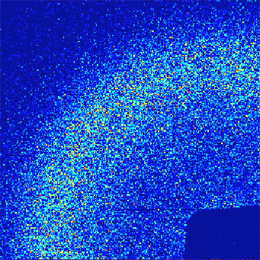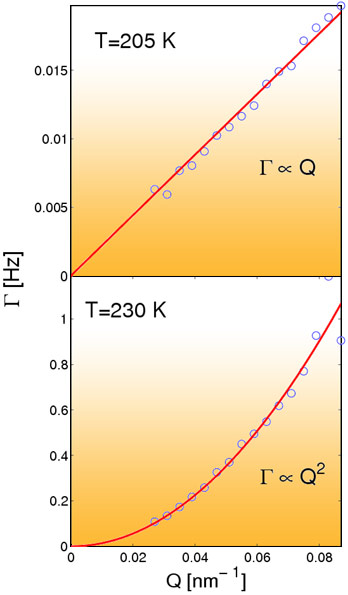- Home
- News
- Spotlight on Science
- Multi-speckle XPCS...
Multi-speckle XPCS using a pixelated 2d detector
12-10-2006
By using the medipix-2 pixel detector, multi-speckle X-ray photon correlation spectroscopy (XPCS) was carried out on suspensions of silica nano-particles in a glass forming solvent. The pixel detector was indispensable for the experiment which indicates a crossover from simple diffusion to cooperative motion of the particles as the glassy state is approached.
Share
X-ray photon correlation spectroscopy (XPCS) is a scattering technique where fluctuations of the scattered intensity are used to extract information about the sample dynamics. When coherent X-rays are scattered from a disordered sample, the diffraction pattern has a grainy appearance, known as speckle, and the fluctuations of an individual speckle are related to the dynamics of the sample at a length scale of 2π/Q where Q is the scattering vector.
In multi-speckle XPCS many speckles are recorded simultaneously with an area detector and hence the signal-to-noise ratio is greatly improved compared to the point detector setup where only a few speckles can be probed at a time. Traditionally, multi-speckle XPCS has been performed by direct illumination of a CCD chip but when used under such conditions the chips are very fragile. Moreover, CCDs have important dark currents, their detection efficiencies are limited at X-ray energies, and energy discrimination is difficult. The largest drawback for XPCS is the slow readout which makes the dead-time large, about 1s for the 1 Mpixel CCD camera at ID10A.
For the first time a pixel detector was used at ESRF’s beamline ID10A for multi-speckle XPCS in the SAXS regime. The Medipix-2 pixel detector [1] is made of a pixelated silicon sensor coupled to an ASIC readout circuit with 256x256 pixels, each pixel acting as an independent photon-counting solid-state detector of 55 x 55 μm2 size. The detector was operated with a full frame rate of 5-30 Hz while recording fluctuating speckles from a suspension of nano-spheres. A real-time movie can be seen in Fig. 1. The frame rate and dynamic range of the movie is far better than offered by our direct illumination CCD camera. With the forthcoming upgrade of the Medipix-2 electronics, it is foreseen that the frame rate will move into the kHz range which certainly will revolutionise the XPCS technique.
Figure 1: Fluctuating speckle pattern from a ~20% vol. solution of 16 nm nanoparticles in propanediol taken at 200K [2]. Please click on the image to download the movie (6 mb, .avi).
The samples were suspensions of spherical silica particles in propanediol. Multi-speckle XPCS analysis yields the particle dynamics which at high temperatures indicate a solvent behaving like a simple liquid on the probed length scales. For instance decay rates Γ of the speckle fluctuations were observed to scale as Γ∝Q2 at 230K (Fig. 2) which point towards single-particle diffusive motion. Near the glass transition of the solvent (TG~200K) the situation has changed and the decay rates scale like Γ∝Q (Fig. 2) which is indicative of collective dynamics. Moreover, in concentrated suspensions at high temperatures a characteristic slowing down of the dynamics near the structure factor peak was observed (de Gennes narrowing). This effect vanishes close to TG which again suggests that the probe sphere dynamics becomes governed by cooperative effects as the glassy state is approached.
Figure 2: Decay rates of the speckle fluctuations vs. momentum transfer for a ~1% vol. solution of 250 nm nanoparticles in propanediol.
References
[1] X. Llopart, M. Campbell, R. Dinapoli, D. SanSegundo, and E. Pernigotti, "Medipix2: a 64-k pixel readout chip with 55 µm square elements working in single photon counting mode", IEEE Trans. Nucl. Sci. 49, 2279 (2002).
[2] Cryostat built by the Sample Environment Group, ESRF.
Authors
C. Caronna, Y. Chushkin, A. Fluerasu, C. Ponchut, and A. Madsen, ESRF





